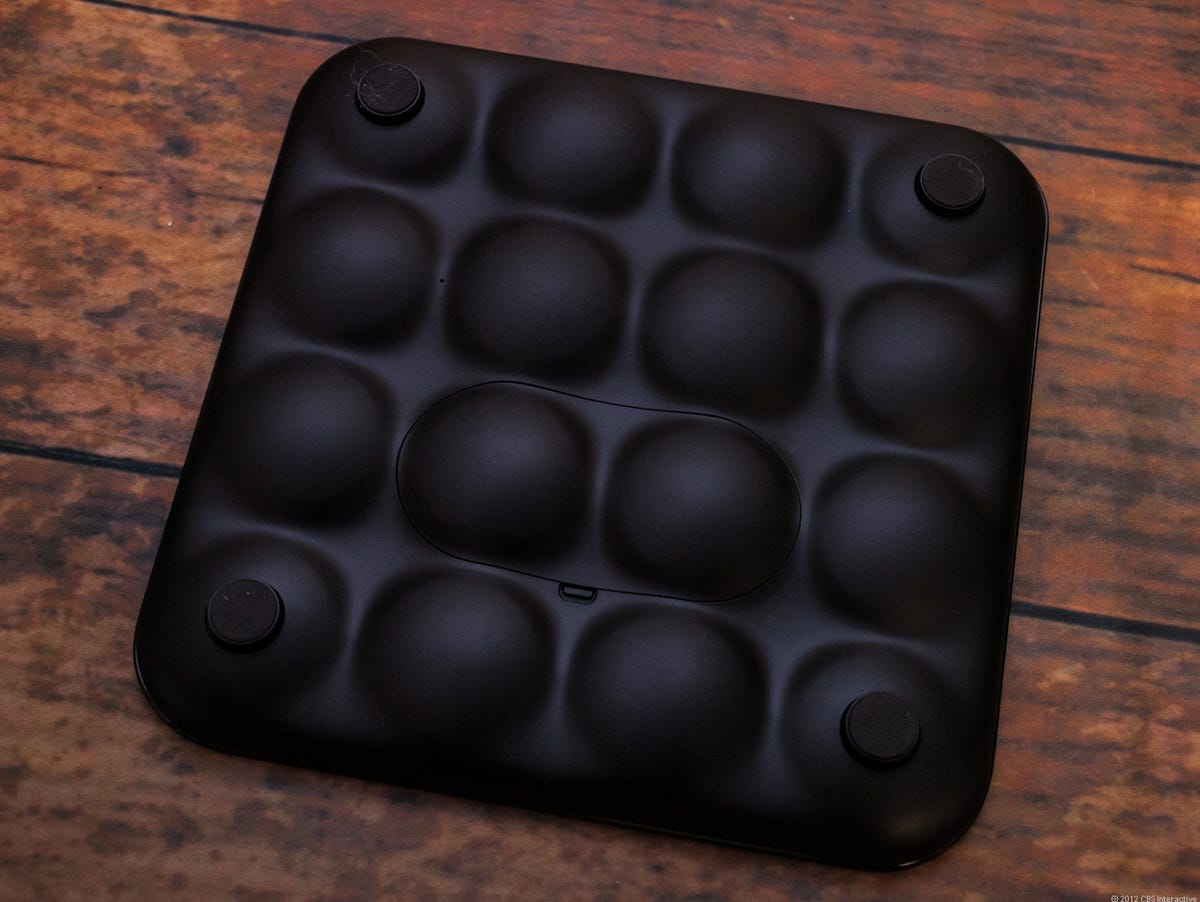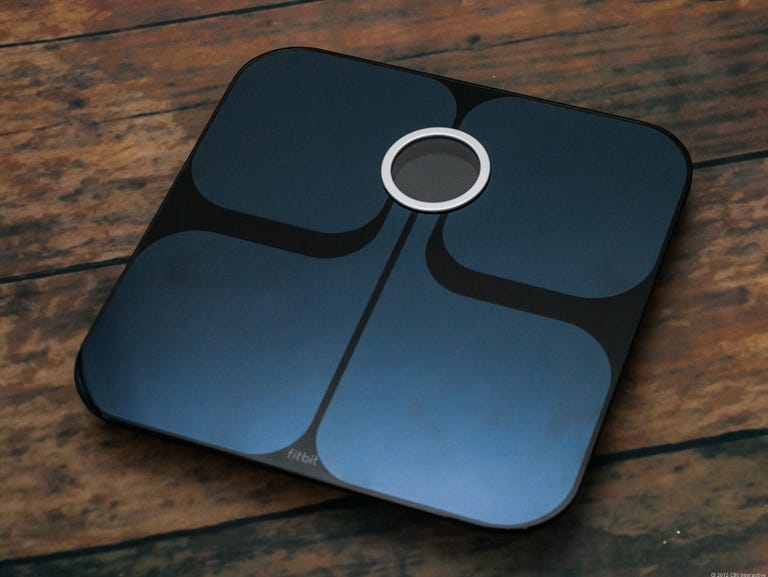 Why You Can Trust CNET
Why You Can Trust CNET Fitbit Aria Wi-Fi Smart Scale review: Fitbit Aria Wi-Fi Smart Scale
Fitbit Aria Wi-Fi Smart Scale
With Roku boxes, game consoles, and Web-enabled HDTVs, there's no question the connected home has become a reality. Now a new gadget, the Wi-Fi bathroom scale, is poised to invade our abodes. The $129.95 Fitbit Aria is a perfect example of this trend. Not only does it promise to record your weight, BMI, and even body fat percentage, it will then shoot your stats to the cloud for analysis and better motivation. That is, if you want to know.
The Good
The Bad
The Bottom Line
Design
I don't often find myself admiring bathroom scales, let alone shopping for one. Even so, when I first gazed upon the Fitbit Aria I was struck by its clean, modern look. Like most commercial scales, the Aria is flat and square. Itself weighing 4.3 pounds, its main sensing platform measures 12.3 inches by 12.3 inches and sits 1.3 inches above the floor.
What's really striking, though, is the platform's all-glass construction. The black Aria unit I tested (it comes in a white version, too) sports a smoky-hued surface that's quite sophisticated. In fact, I prefer the Aria's style over its main competitor, the Withings Body Scale. Not only is the Aria almost a pound lighter, but also its build quality feels higher. I'm especially fond of the Aria's underside, which is made from a pattern of 16 bubblelike protrusions.

The design element is eye-catching, but I suspect that it also works to strengthen the scale by distributing weight evenly. By contrast, the flat bottom of the Withings Body Scale flexes disconcertingly when I apply pressure to it with my fingers. Its four plastic feet also rattle around in their sockets, whereas the Aria's rubber risers are stable and provide a surer grip. Also on the bottom of the scale is the battery compartment, which holds four AA batteries.
A silvery metal ring on the Aria's top center encircles a backlit LCD that displays a wide variety of information. As you'd expect, the screen prominently shows your weight. It also displays various notifications and alerts including battery status and Wi-Fi signal strength plus the progress of various tasks like measuring weight or capturing body composition.
Features
Thinking of the Fitbit Aria as a mere scale is woefully inaccurate. It's more of a "smart measurement device" or a networked home appliance. Of course, the Aria's primary function is to record your weight, but just like the Withings Body Scale, the Aria will determine your body fat percentage and calculate your Body Mass Index (BMI). It does this by sending a tiny electrical signal through your body to differentiate between lean mass, such as muscle, and fat tissue. That's why the Aria's manual repeatedly states never to use the scale if you rely on a pacemaker. Sounds like a good rule to follow.
The scale is intelligent enough to recognize up to eight different people. Each person does have to create a Fitbit account and register with the Aria device via the Fitbit Web site. In fact, as with Fitbit's Ultra pedometer, the real power of the Aria resides in its Web-based software and deep analytical tools that live online. Once the Aria has recorded your weight and other stats, it automatically transmits the data to Fitbit's servers in the cloud via its Wi-Fi radio. After the scale populates your Fitbit account with this information, the fun, or the pain (depending on the reading), really begins.
Essentially, your Fitbit account is a personal fitness profile that tracks your daily and weekly activity, as measured by the Fitbit Ultra, against a comprehensive calorie counter. The introduction of the Aria, though, adds the final piece of the data puzzle: your weight recorded over time. What's more, the Fitbit provides free mobile apps for both iOS and Android, through which users can track their current activity level and calorie intake. The software offers a method of logging meals and snacks and manually entering workouts.
But that's not all. To motivate yourself further, and shame yourself with the truth, you can use your Fitbit account to set goals for weight loss and verify your progress with daily weigh-ins on the Aria scale. If you achieve hard-earned weight loss, the Aria will congratulate you with nifty badges that you can then use to gloat via Facebook or Twitter or to friends with Fitbit accounts. Fortunately, that last step is optional.
Acknowledging that many people already use fitness software to keep tabs on their health and workouts, Fitbit supports 13 popular third-party applications including Lose It, Endomondo, and TargetWeight. Yet, compared with the Withings Body Scale, that's a paltry showing. The Body Scale connects to a whopping 44 health-centric apps and online services including RunKeeper and even Fitbit. The Body Scale, however, lacks the breadth and reach of Fitbit's analytical tools and merely plots scale measurements over time. More detailed assessment, fitness, and nutritional planning must be done through Withing's third-party partners.
Ease of setup is one area where the Fitbit Aria trumps the Withings Body Scale. The Aria has a completely wireless installation process whereas the Body Scale requires you to connect the device at least once to your Wi-Fi-connected PC via a USB cable. It's a minor inconvenience but if you misplace the cord (USB-to-Mini-USB) and change your home network settings, you'll be in a real jam.
Performance
In my brief test period with the Fitbit Aria I came away very impressed. Setting up the device on my home network was a snap, taking about 5 minutes to complete. First I made sure the four bundled AA batteries were properly in place and the Aria was in its setup mode. Then I pointed my browser to www.fitbit.com/start and downloaded the Aria client software. The software pushed me through a simple wizard that helped me log into my Fitbit account, name the scale, and enter my Wi-Fi network details. The Aria client then communicated the network log-in information to the scale and confirmed success.
Using the Aria is just as straightforward: just step on the device, preferably with bare feet to ensure proper BMI measurement, and wait a few seconds. In my experience, the Aria recognized me and began sensing my body before entering a "thinking" mode where it calculated my weight and percent body fat. Once done, the Aria instructed me to step off and it immediately uploaded my new stats to Fitbit's servers. The whole process took about 10 seconds, which wasn't that traumatic. What the scale reported though was very distressing.
Glaring at me in cold white digits was the reading of 224.8 pounds. "Hell no!" I told myself, but deep down I knew it was true. Less than 10 months ago, just before my twins were born, I tipped the scales at a much trimmer 206 pounds. That's lighter than when I was the dedicated karateka of my youth, though I definitely had more muscle mass as well. If my new weight isn't a kick in the gut to get back down to fighting size, I don't know what is.
To be fair, last year I stuck to my wife's strict predelivery diet, which cut out most refined carbs and sugars. Thankfully, the online tools Fitbit provides quickly let me draft a weight-loss plan determined by my calorie intake, measured weight, and activity level. Using the company's Android app is also easy and conveniently let me log foods soon after meals. If all goes well, I'll be fit as a fiddle by August.
Conclusion
Despite being a fan of the Fitbit Ultra, I was frankly dubious about the need for a smart scale. I'm probably one of the few people in America who bought a Nintendo Wii Fit way back when and have been soured by the dull and at times insulting motivation it served up. My feeling, though, is that if you can afford to splurge on a $129.99 scale and have already invested in Fitbit's ecosystem, the Aria is a worthwhile addition. It's better-looking, easier to install than the $159 Withings Body Scale, and just as accurate. If you need a scale that supports a wide range of fitness apps and services, however, the Body Scale is a compelling alternative.


